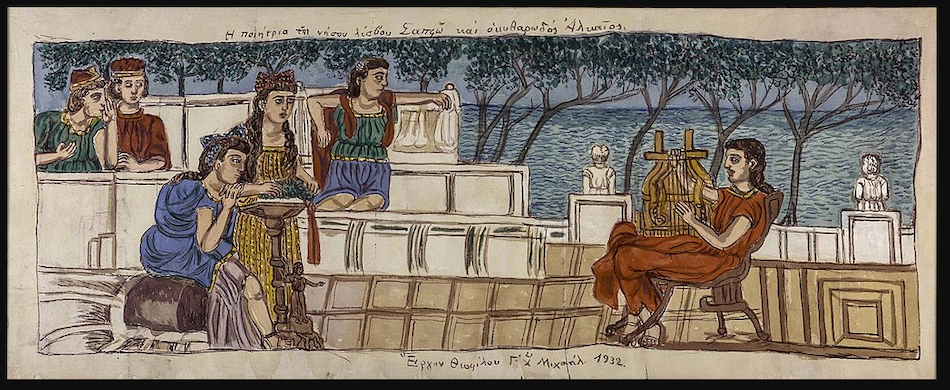Will a New Patron Rescue the Legacy of Theophilos, the Michaelangelo of Lesbos?
The folk artist’s work proved controversial in post-war Greece. Were the paintings too Stalinist or not Stalinist enough? All things Theophilos have calmed down considerably since that time.

LESBOS, Greece — Every municipality has its local hero, but some are more local than others. The Greek island of Lesbos, an island of 83,000-some citizens that is a brief boat ride away from Turkey in the northeast Aegean, has seen its share of international attention in recent years due to the influx of refugees. Yet the island is also distinguished by circumstances that are less traumatic, if no less world historical.
Aristotle traveled to Lesbos in the 4th century B.C. and cataloged the island’s fish, flora, and fauna, thereby — according to some scholarly lights, anyway — “inventing science.” Roughly two centuries earlier, the Lesbos-born poet Sappho waxed lyrical on the virtues of love. Although there is no definitive proof of Sappho’s sexual longings for women, she’s the reason the word “lesbian” is significantly more than a geographical marker.
Then there’s Lesbos’s home-grown visionary, Theophilos Hatzimihail, a Greek Le Dounier Rousseau known for wearing a pleated, skirt-like folk costume, the fustanella, and depicting scenes that stemmed from myth and history. This “day dreamer, eccentric, and lover of all things Greek” may have garnered tips about painting from his grandfather the iconographer, but his skill set was largely self-generated, he being less a student of the academy than one driven by his own inclinations.
Theophilos — like Michelangelo and Cher, he’s popularly referred to by one name — was born around 1870. He left home at the age of 18 and traveled to Smyrna, where he worked as a gatekeeper at the Greek consulate. A subsequent move to a port city on the Greek mainland, Volos, led to the patronage of Giannis Kontos, a landowner of some import. Theophilos in 1927 returned to Lesbos, where he caught the eye of a fellow native, Stratis Eleftheriades, a book publisher and art world insider better known as Tériade.
Having hobnobbed with the likes of Picasso, Matisse, and Chagall while studying law at Paris, Tériade was wise to the attractions of folk art. He took Theophilos under his wing, commissioned a raft of paintings, and provided the painter with a degree of financial stability.

Via Theophilos Museum, Mytilene, Greece
After the artist’s death in 1934, Tériade saw fit to promote the paintings at Paris: He curated a show of the artist’s work at the Louvre. Yet Theophilus’s work proved controversial in post-war Greece. Were the paintings too Stalinist or not Stalinist enough? All things Theophilos have calmed down considerably since that time.
Given the ubiquity of Byzantine art in Greece, Theophilos’s style is often viewed as, if not strictly an extension of its parameters, then part and parcel of them. An observer would be foolhardy to question how thoroughly native artforms are part of a country’s cultural DNA, but the paintings themselves are fairly commensurate with outsider art seen the world over. An abiding compositional frontality; a sense that an image is an inventory, rather than an embodiment, of people, places, and things; a skewed sense of pictorial space; and a narrow aesthetic purview — these are the limitations, as well as the charms, of Theophilos’s pictures.
This isn’t to say that all things Theophilos have become sacrosanct. Although a museum dedicated exclusively to the artist was established in 1965 through the offices of Tériade and Kontos — it can be found at Vareia, a district of Mytilini, the capital of Lesbos — Theophilos’s tree is markedly down at the heels. His tree, you say? Theophilos’s spring-time pied-à-terre, a venue that doubled as a studio, is a hollowed-out tree situated at Karini. Duck inside, listen to the wind creak its way through gaps in the trunk, and imagine the refuge it was for a local eccentric who often suffered the taunts of his countrymen.
After that, despair at its surroundings: an adjoining taverna has been abandoned and its pond is uncared for. What looks to be a mural by Theophilos across the pathway is, it would seem, in an irreparable state. Surely there’s a 21st century Tériade somewhere on the island to do right by a figure whom, as noted by the novelist Stratis Myrivilis, “the critics of Athens and Paris proclaimed … a great painter.”

